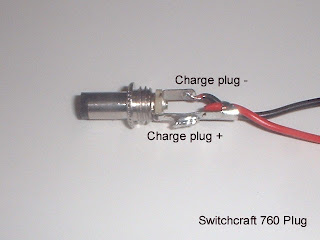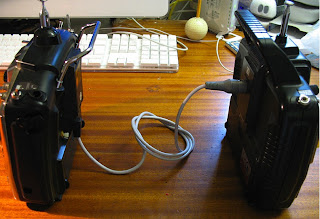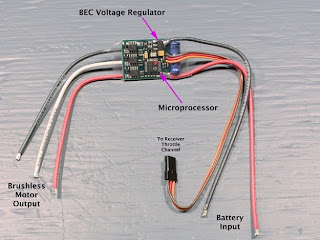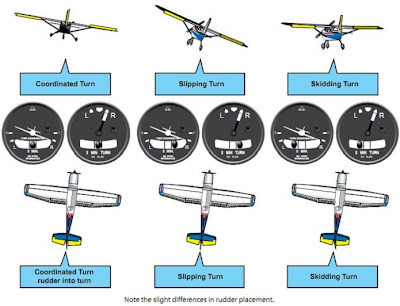Monday, May 20, 2013
Charge Jack:
The plug receptacle of the switch harness into which the charger is plugged to charge the airborne battery. An expanded scale voltmeter (ESV) can also be plugged into it to check battery voltage between flights. It is advisable to mount the charge jack in an accessible area of the fuselage so an ESV can be used without removing the wing.
Posted on Monday, May 20, 2013 by Admin OG
CG ("Center of Gravity"):
For modeling purposes, this is usually considered -- the point at which the airplane balances fore to aft. This point is critical in regards to how the airplane reacts in the air. A tail-heavy plane will be very snappy but generally very unstable and susceptible to more frequent stalls. If the airplane is nose heavy, it will tend to track better and be less sensitive to control inputs, but, will generally drop its nose when the throttle is reduced to idle. This makes the plane more difficult to land since it takes more effort to hold the nose up. A nose heavy airplane will have to come in faster to land safely.
Posted on Monday, May 20, 2013 by Admin OG
Wiki:
A carburetor (American and Canadian spelling), carburator, carburettor, or carburetter (Commonwealth spelling) is a device that blends air and fuel for an internal combustion engine. It is sometimes, but not always, shortened to carb in North America and the United Kingdom.
Slide Carburetors
A slide carburetor has a throttle valve that slides out the side. This reduces air restriction, for better performance, and requires the servo to move less to open it fully, for better throttle response. They also require a more precise alignment of the carburetor and throttle servo to prevent binding, which can result in dangerous stuck throttle conditions, which can often only be resolved by killing the engine after the vehicle is stopped by a large immobile object like a tree. Slide carbs are used on all big block nitro engines, and on many small block nitro engines. They are fairly prone to sticking because of dirt, and on land vehicles, an air filter is always used.
Rotary Carburetors
Rotary carburetors have a barrel with a hole in it that rotates. This takes more servo movement to completely open, and reduces throttle resopnse. They also have more restriction, which can reduce overall power. Some people feel that these are better for offroad use, because they have more throttle range. They aren't used on big block engines. They are as prone to dirt as a slide carb.
Butterfly Carburetors
Butterfly carburetors are common on gasoline RC engines and small 2 stroke engines designed for other purposes but used on RCs. They have a butterfly, or a thin piece of metal that rotates to open the throttle. They don't stick when they get dirty, but the dirt can still cause engine damage and poor performance. These carburetors are also used in alot of full scale applications, like cars and lawnmowers. They often have a second butterfly as a choke valve, to reduce air flow, temporarily richening the mixture for easier starting. These carburetors have more restriction then other carburetors, but the engines they are used on are larger, and the performance doesn't matter as much.
 |
| Nitro Rc Engine Diagram |
- Cylinder Head
- Glow Plug
- Pullstart
- Combustion Chamber
- Piston
- Exhaust port
- Carburetor
- Mixture needle
- Idle screw
- Throttle linkage
- Crankcase
- Crankshaft
Posted on Monday, May 20, 2013 by Admin OG
Sunday, May 12, 2013
Buddy Box Meaning:
Two similar transmitters that are wired together with a "trainer cord." This is most useful when learning to fly -- it's the same as having dual controls. The instructor can take control by using the "trainer switch" on his transmitter.
Training method utilizing two transmitter control boxes, linked together. The trainer radio has override control, which the instructor uses to take control when the trainee looses control, or becomes disoriented.
Wiki:
Buddy box or buddy boxing is a colloquialism referring to two R/C aircraft radio systems joined together for pilot training purposes.
This training system is universal among the five major R/C radio manufacturers (Futaba, JR, Hitec, Airtronics and KO Propo) which means that transmitters do not have to be the same brand in order to be joined via an umbilical cable. There are, however, two different types of DIN cable connectors used for the purpose and the two are incompatible. Therefore, both transmitters must have the same type of receptacle in order to operate together.
Buddy boxing is accomplished by joining the student and master transmitters via the aforementioned cable and making sure that the servo reversing switches and trims are set identical on both. The student is given control of the aircraft via a long-handled, spring-loaded switch on the top left corner of most transmitters located on the master transmitter, normally held by the instructor. When the switch is pulled forward and held on by the instructor's left index finger, control of the aircraft is at the student's transmitter. Should the instructor judge that the student is encountering difficulty in flight, control is transferred to the master transmitter merely by releasing the switch. (On some older Futaba radios such as the popular 6XA, the trainer switch is actually a push-button located in the corner, the aforementioned corner toggle switch is reserved for channel 5 - landing gear.)
The two transmitters need not be on the same frequency. The master transmitter is the one that actually flies the plane; buddy boxing turns the student transmitter into a "dummy" remote control of the master. The student transmitter is operated with power switched off as power for both is provided by the master. The student transmitter will power up via the umbilical despite being switched off.
Two similar transmitters that are wired together with a "trainer cord." This is most useful when learning to fly -- it's the same as having dual controls. The instructor can take control by using the "trainer switch" on his transmitter.
Training method utilizing two transmitter control boxes, linked together. The trainer radio has override control, which the instructor uses to take control when the trainee looses control, or becomes disoriented.
Wiki:
Buddy box or buddy boxing is a colloquialism referring to two R/C aircraft radio systems joined together for pilot training purposes.
This training system is universal among the five major R/C radio manufacturers (Futaba, JR, Hitec, Airtronics and KO Propo) which means that transmitters do not have to be the same brand in order to be joined via an umbilical cable. There are, however, two different types of DIN cable connectors used for the purpose and the two are incompatible. Therefore, both transmitters must have the same type of receptacle in order to operate together.
Buddy boxing is accomplished by joining the student and master transmitters via the aforementioned cable and making sure that the servo reversing switches and trims are set identical on both. The student is given control of the aircraft via a long-handled, spring-loaded switch on the top left corner of most transmitters located on the master transmitter, normally held by the instructor. When the switch is pulled forward and held on by the instructor's left index finger, control of the aircraft is at the student's transmitter. Should the instructor judge that the student is encountering difficulty in flight, control is transferred to the master transmitter merely by releasing the switch. (On some older Futaba radios such as the popular 6XA, the trainer switch is actually a push-button located in the corner, the aforementioned corner toggle switch is reserved for channel 5 - landing gear.)
The two transmitters need not be on the same frequency. The master transmitter is the one that actually flies the plane; buddy boxing turns the student transmitter into a "dummy" remote control of the master. The student transmitter is operated with power switched off as power for both is provided by the master. The student transmitter will power up via the umbilical despite being switched off.
Posted on Sunday, May 12, 2013 by Admin OG
Saturday, May 11, 2013
A circuit that eliminates the need for a receiver battery, usually in electric R/C cars and boats.
Wiki:
A battery eliminator circuit (BEC) is an electronic circuit designed to deliver electrical power to other circuitry without the need for a battery. Historically the expression was sometimes used to describe devices used to power battery-driven equipment from mains electricity. This is still the case in many products offered in retail electronic supply stores.
Wiki:
A battery eliminator circuit (BEC) is an electronic circuit designed to deliver electrical power to other circuitry without the need for a battery. Historically the expression was sometimes used to describe devices used to power battery-driven equipment from mains electricity. This is still the case in many products offered in retail electronic supply stores.
Posted on Saturday, May 11, 2013 by Admin OG
Friday, May 10, 2013
Thursday, May 9, 2013
Some cars and trucks are available virtually prebuilt and will be indicated by the terms ARR (Almost-Ready-To-Run) or RTR (Ready-To-Run). The ARR/RTR vehicles cost a little more, but if you're just not interested in building your car, this is an option for you. Most vehicles, however, come in kit form and require you to do the building. This may require a few evenings, but the familiarity you gain from assembly will make repairs, adjustments and modifications easier to make down the road.
Posted on Thursday, May 09, 2013 by Admin OG
Wednesday, May 8, 2013
Monday, May 6, 2013
These letters stand for aluminum, brass and chrome or a composite such as nickel. These engines have an aluminum piston and a chrome or composite coated brass cylinder sleeve which allows them to be more efficient for higher performance. They have no piston ring and rely on a very tight piston/cylinder fit to obtain a piston/cylinder seal. New ABC engines are normally hard to turn over by hand. Because of the tight fit, it is very important that the engine is broken in properly.
Posted on Monday, May 06, 2013 by Admin OG
As in full-scale cars, there are two main drive types: two-wheel drive (2WD) where power is supplied to the two rear wheels, and four-wheel drive (4WD) where power is supplied to all four wheels. The 2WD vehicles are less expensive and require less overall assembly and maintenance than 4WD vehicles. Assembly and maintenance for 4WD vehicles tends to be more involved, though not necessarily more difficult; the trade-off is that 4WD vehicles offer better steering through turns.
Posted on Monday, May 06, 2013 by Admin OG
Friday, May 3, 2013
Ailerons that are set up to deflect more in the upward direction than downward are said to have Differential Throw. The purpose is to counteract Adverse Yaw.
Posted on Friday, May 03, 2013 by Admin OG
The tendency of an airplane to yaw in the opposite direction of the roll. For instance, when right aileron is applied, the airplane yaws to the left, thus opposing the turn. Adverse yaw is common in trainer type airplanes having flat bottom wings. It is most noticeable at slow speeds and high angles of attack, such as during takeoffs and when stretching a landing approach. Caused by the unequal drag of the upward and downward deflection of the ailerons, this undesirable trait can be minimized by setting up the ailerons with Differential Throw or by coordinating the turns, using the aileron and rudder controls simultaneously. (See Differential Throw.)
Posted on Friday, May 03, 2013 by Admin OG
Subscribe to:
Posts (Atom)
Categories
- Battery (5)
- Cars (3)
- Engine (5)
- Heli (2)
- Rc Dictionary (44)
- Rc-Helicopter (2)
- Trucks (2)
Popular Posts
-
Image: Dihedral Dihedral: The V-shaped bend in the wing. Typically, more dihedral causes more aerodynamic stability in an airplane, ...
-
A 2.4GHz radio system which selects one (or two) of the available " free " frequencies and transmits only on the one(s) chosen....
-
A hand-held stick used to "flip start" a model airplane engine . The Hobbico Safe Start " chicken stick " is a saf...
-
Flutter: A phenomenon whereby the elevator or aileron control surface begins to oscillate violently in flight . This can sometimes cause th...
-
Flight Box : A special box used to hold and transport all equipment used at the flying field. Flight Box
-
Hinged control surfaces located on the trailing edge of the wing, one on each side, which provide control of the airplane about the rol...
-
The tendency of an airplane to yaw in the opposite direction of the roll. For instance, when right aileron is applied, the airplane yaws t...
-
CG (" Center of Gravity "): For modeling purposes, this is usually considered -- the point at which the airplane balances fore t...
-
The angle that the wing penetrates the air. As the angle of attack increases so does lift and drag , up to a point .
-
Elevator : Hinged control surface located at the trailing edge of the horizontal stabilizer , which provides control of the airplane about t...





























